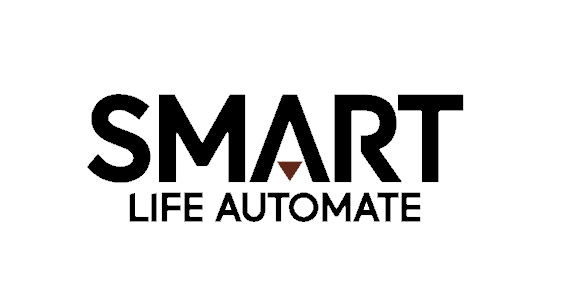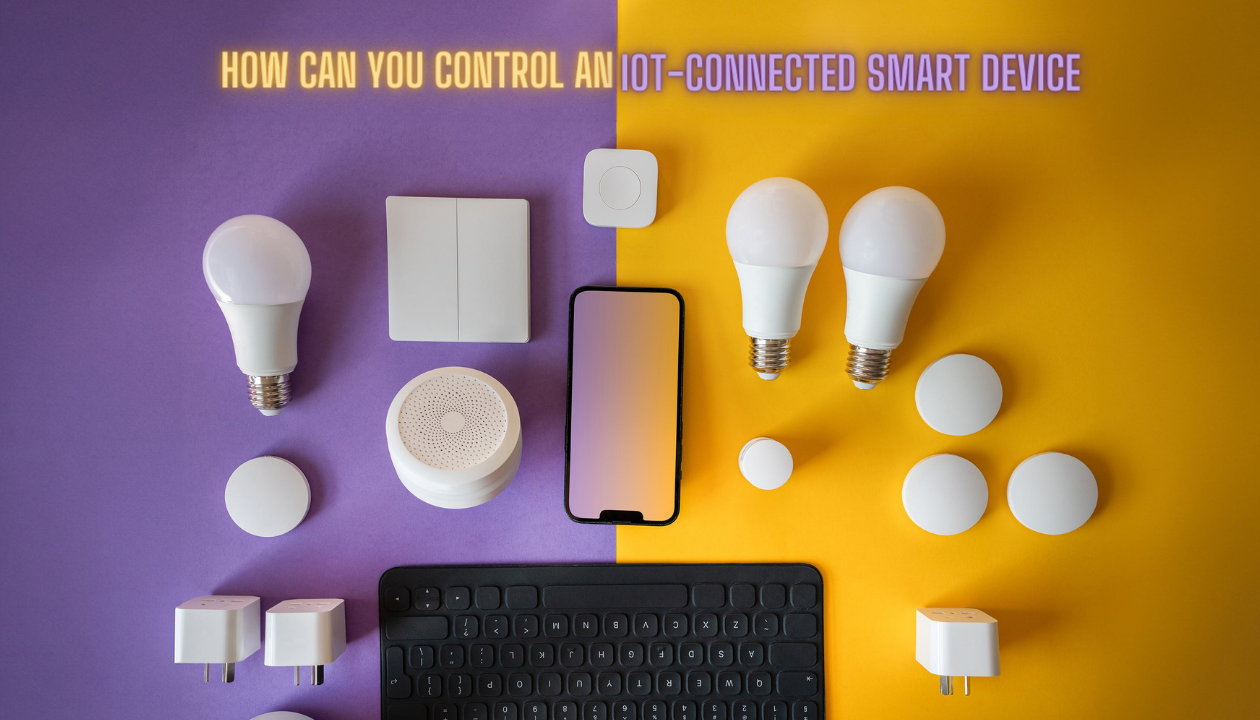Introduction to IoT and Smart Devices:
In the sector of modern generation, the Internet of Things (IoT) has emerged as a transformative pressure, revolutionizing the way we interact with our surroundings. IoT refers back to the interconnectedness of numerous gadgets via the net, allowing them to speak, gather facts, and perform obligations autonomously. Among the ones devices, smart gadgets stand out, encompassing a numerous array of gadgets ranging from smart thermostats and lighting fixtures to protection cameras and kitchen appliances. So, how can you control an IoT-connected smart device?

Understanding IoT-Connected Smart Devices:
The Internet of Things (IoT) is a idea that bridges the digital and physical realms. It entails connecting everyday objects and gadgets to the internet, permitting them to collect information, talk, and perform moves. Here are the important thing factors:
Sensors and Actuators: Physical objects are embedded with sensors that monitor adjustments inside the environment (such as temperature or movement). These sensors communicate with actuators, which respond to the sensor facts by appearing precise moves.
Wired and Wireless Networks: Sensors and actuators join thru stressed (e.g, Ethernet) or wireless (e.g., WiFi, cell) networks to computing structures.
Constant Connectivity: IoT enables non-stop connectivity, permitting actual-time monitoring and control of related objects.
Applications: IoT has packages across diverse settings, which include human fitness, homes, retail environments, workplaces, manufacturing centers, and automobiles.
Smart devices depend on IoT to hook up with sensors. These sensors collect data from their surroundings, whether or not or no longer it’s temperature, motion, or distinct environmental changes. Smart devices can store this information, share it with different clever gadgets, and behavior statistics analyses to provide valuable insights to customers. So, how can you control an IoT-connected smart device?
The way IoT works includes devices ready with hardware (consisting of sensors) amassing facts. The gathered statistics is shared through the cloud and included with software. The software analyzes and transmits the data to customers through apps or websites. So, how can you control an IoT-connected smart device?
In summary, IoT-related clever gadgets beautify our lives through seamlessly integrating technology, facts, and connectivity. From wearable fitness trackers to domestic automation structures, IoT maintains to form the way we interact with our environment and improve operational performance across industries.

How Can You Control an IoT-Connected Smart Device
Centralized Control Hub:
A centralized manipulate hub acts as a command center for dealing with multiple IoT devices. It consolidates manipulate and monitoring features into a single interface. Here’s how it works: How Can You Control an IoT-Connected Smart Device?
- Smart Home Hubs: Devices like Amazon Echo, Google Nest Hub, or Samsung SmartThings serve as hubs. They connect with diverse clever gadgets (lighting, thermostats, cameras) and could will let you manipulate them from one vicinity.
- Benefits: Simplified management, unified voice manage, and compatibility with one of a kind manufacturers.
Voice Commands:
Voice-managed assistants, together with Amazon Alexa, Google Assistant, or Apple Siri, enable fingers-loose interaction with IoT gadgets. Here’s the manner it operates:
- Activation: Say a wake phrase (e.G., “Alexa” or “Hey Google”) followed with the aid of a command.
- Actions: Control lighting fixtures, modify thermostats, play track, or set reminders the use of herbal language.
- Integration: These assistants hyperlink to well matched devices and execute your requests.
- Privacy: Be conscious that voice data is despatched to cloud servers for processing.
Custom Automation Routines:
Automation workouts can help you create personalised sequences of moves. For example:
- Morning Routine: Automatically turn on lighting fixtures, adjust thermostat, and play the news when you wake up.
- Away Mode: Set lighting fixtures to random styles whilst you’re no longer home for protection.
- Integration: Use apps like IFTTT (If This, Then That) or SmartThings to build custom workouts.
Remote Monitoring and Control:
- Mobile Apps: Dedicated apps for each tool permit you to monitor and manage them remotely.
- Web Interfaces: Log in thru an internet browser to manage settings, view facts, and receive indicators.
- Benefits: Check security cameras, adjust smart plugs, or lock doors from anywhere.
In summary, whether through mobile apps, voice commands, custom routines, or remote interfaces, controlling IoT devices offers flexibility and convenience. Choose the method that suits your preferences and enhances your smart home experience!

Security Considerations:
As the proliferation of IoT-connected smart gadgets maintains to expand, ensuring robust safety features is paramount. With cybersecurity threats on the upward push, shielding sensitive information and safeguarding privacy will become more and more crucial.
Implementing encryption protocols, normal firmware updates, and multi-aspect authentication mechanisms are critical steps to mitigate security risks and protect towards unauthorized get admission to and data breaches. So, how can you control an IoT-connected smart device?
Use Cases and Real-Life Examples:
The versatility and practicality of IoT-linked clever devices are evident throughout diverse domains, from home automation and healthcare to industrial programs and clever towns. In the world of domestic automation, smart thermostats like Nest Learning Thermostat optimize energy consumption and enhance comfort with the aid of learning user alternatives and adjusting settings therefore.
In healthcare, wearable gadgets prepared with biometric sensors permit far off patient tracking and early detection of health issues, improving affected person results and decreasing healthcare fees. So, how can you control an IoT-connected smart device?

Future Trends and Challenges:
Looking in advance, the evolution of IoT-connected smart devices is poised to maintain, pushed with the aid of improvements in artificial intelligence, facet computing, and 5G connectivity. Enhanced interoperability, seamless integration, and stepped forward power efficiency are among the key trends shaping the destiny of IoT technology.
However, demanding situations such as interoperability troubles, privateness issues, and cybersecurity threats continue to be significant hurdles that should be addressed to realize the whole potential of IoT-driven innovation. So, how can you control an IoT-connected smart device?
The Importance of IoT Device Control
In the age of smart generation, controlling IoT devices extends some distance beyond mere comfort; it serves as a essential element in optimizing domestic and office environments for electricity performance, security, and private comfort. Proficiency in managing those gadgets allows users to customize their surroundings in line with their character possibilities, behavior, and way of life necessities, thereby extensively elevating their normal first-rate of existence. So, how will you manage an IoT-related smart device?
Conclusion:
In conclusion, IoT-related clever gadgets represent a paradigm shift within the way we have interaction with generation, providing extraordinary convenience, performance, and connectivity. By leveraging centralized manipulate hubs, voice instructions, custom automation exercises, and remote tracking capabilities, customers can harness the overall potential of IoT generation to beautify their every day lives. However, ensuring strong safety functions and addressing growing challenges are important to identifying the promise of IoT-driven innovation. So, how will you manage an IoT-related smart device?
FAQs
How do I control IoT devices?
In the area of modern-day technology, the Internet of Things (IoT) has emerged as a transformative force, revolutionizing the manner we’ve got interplay with our surroundings. IoT refers to the interconnectedness of numerous devices via the net, allowing them to speak, collect information, and carry out responsibilities autonomously. Among these devices, clever gadgets stand out, encompassing a diverse array of devices starting from smart thermostats and lighting fixtures to protection cameras and kitchen appliances. How Can You Control an IoT-Connected Smart Device: Use cell packages, voice instructions, internet interfaces, custom automation workouts, or remote monitoring to control your clever devices efficiently. These strategies enhance comfort and empower customers to seamlessly manage their smart homes!
What are the types of control systems in IoT?
In the context of IoT-related smart gadgets, manage structures play a vital function in handling and optimizing device overall performance. Let’s explore the foremost types of IoT controllers:
Hardware-Based Controllers:
- These are small, low-electricity gadgets that without delay connect with the net the use of wi-fi protocols consisting of Wi-Fi, Bluetooth, or Zigbee.
- Hardware-based controllers act as bridges among the devices and the cloud or other remote servers.
- They offer a centralized factor of manage for coping with related devices, allowing real-time statistics analysis and selection-making.
Software-Based Controllers:
- Deployed in the cloud, software-based controllers rely on APIs and other web services to interact with connected devices.
- They facilitate communication and coordination between different IoT devices.
- Software controllers analyze data, execute commands, and monitor device performance1.
In summary, both hardware-based and software-based IoT controllers contribute to seamless connectivity, data management, and intelligent decision-making within IoT systems.

